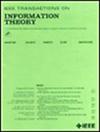Entanglement Cost of Discriminating Quantum States Under Locality Constraints
IF 2.2
3区 计算机科学
Q3 COMPUTER SCIENCE, INFORMATION SYSTEMS
引用次数: 0
Abstract
The unique features of entanglement and non-locality in quantum systems, where there are pairs of bipartite states perfectly distinguishable by general entangled measurements yet indistinguishable by local operations and classical communication, hold significant importance in quantum entanglement theory, distributed quantum information processing, and quantum data hiding. This paper delves into the entanglement cost for discriminating two bipartite quantum states, employing positive operator-valued measures (POVMs) with positive partial transpose (PPT) to achieve optimal success probability through general entangled measurements. We first introduce two quantities called the spectral PPT-distance and relative spectral PPT-distance of a POVM to quantify the localness of a general measurement. We show these quantities are related to the entanglement cost of optimal discrimination by PPT POVMs. Following this, we establish bounds and develop SDP hierarchies to estimate the entanglement cost of optimal discrimination by PPT POVMs for any pair of states. Leveraging these results, we show that a pure state can be optimally discriminated against any other state with the assistance of a single Bell state. This study advances our understanding of the pivotal role played by entanglement in quantum state discrimination, serving as a crucial element in unlocking quantum data hiding against locally constrained measurements.局域约束下判别量子态的纠缠代价
量子系统中的纠缠和非局部性的独特特征,即存在着对二部态,可以被一般的纠缠测量完全区分,但局部运算和经典通信却无法区分,这在量子纠缠理论、分布式量子信息处理和量子数据隐藏中具有重要意义。本文研究了判别两个二部量子态的纠缠代价,采用正偏转置(PPT)的正算子值测度(POVMs),通过一般的纠缠测度获得最优的成功概率。首先,我们引入了两个量,称为光谱ppt距离和相对光谱ppt距离的POVM来量化一般测量的局域性。我们表明这些数量与PPT povm的最佳识别纠缠成本有关。在此基础上,我们建立了边界并建立了SDP层次结构,以估计PPT povm对任何状态的最优判别的纠缠成本。利用这些结果,我们表明,在单个贝尔状态的帮助下,纯状态可以最优地区别于任何其他状态。这项研究促进了我们对纠缠在量子态辨别中所起的关键作用的理解,它是解开隐藏在局部约束测量中的量子数据的关键因素。
本文章由计算机程序翻译,如有差异,请以英文原文为准。
求助全文
约1分钟内获得全文
求助全文
来源期刊

IEEE Transactions on Information Theory
工程技术-工程:电子与电气
CiteScore
5.70
自引率
20.00%
发文量
514
审稿时长
12 months
期刊介绍:
The IEEE Transactions on Information Theory is a journal that publishes theoretical and experimental papers concerned with the transmission, processing, and utilization of information. The boundaries of acceptable subject matter are intentionally not sharply delimited. Rather, it is hoped that as the focus of research activity changes, a flexible policy will permit this Transactions to follow suit. Current appropriate topics are best reflected by recent Tables of Contents; they are summarized in the titles of editorial areas that appear on the inside front cover.
 求助内容:
求助内容: 应助结果提醒方式:
应助结果提醒方式:


